Related Research Articles
In physics, natural abundance (NA) refers to the abundance of isotopes of a chemical element as naturally found on a planet. The relative atomic mass of these isotopes is the atomic weight listed for the element in the periodic table. The abundance of an isotope varies from planet to planet, and even from place to place on the Earth, but remains relatively constant in time.
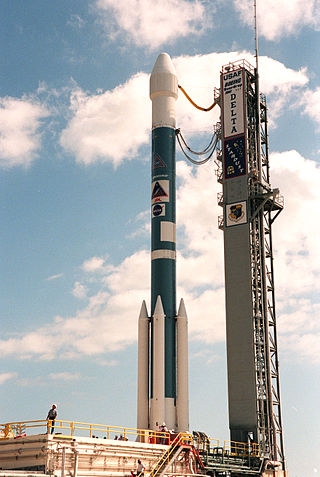
Presolar grains are interstellar solid matter in the form of tiny solid grains that originated at a time before the Sun was formed. Presolar stardust grains formed within outflowing and cooling gases from earlier presolar stars.
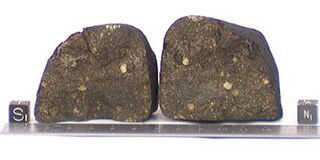
Cosmochemistry or chemical cosmology is the study of the chemical composition of matter in the universe and the processes that led to those compositions. This is done primarily through the study of the chemical composition of meteorites and other physical samples. Given that the asteroid parent bodies of meteorites were some of the first solid material to condense from the early solar nebula, cosmochemists are generally, but not exclusively, concerned with the objects contained within the Solar System.
The slow neutron-capture process, or s-process, is a series of reactions in nuclear astrophysics that occur in stars, particularly asymptotic giant branch stars. The s-process is responsible for the creation (nucleosynthesis) of approximately half the atomic nuclei heavier than iron.
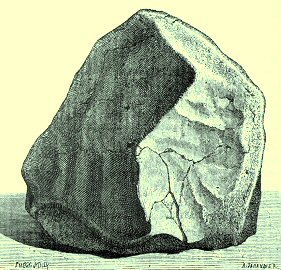
Orgueil is a scientifically important carbonaceous chondrite meteorite that fell in southwestern France in 1864.
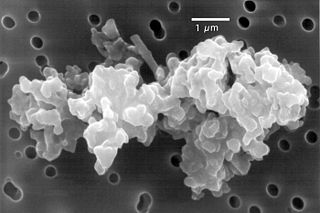
Cosmic dust – also called extraterrestrial dust, space dust, or star dust – is dust that occurs in outer space or has fallen onto Earth. Most cosmic dust particles measure between a few molecules and 0.1 mm (100 μm), such as micrometeoroids. Larger particles are called meteoroids. Cosmic dust can be further distinguished by its astronomical location: intergalactic dust, interstellar dust, interplanetary dust, and circumplanetary dust. There are several methods to obtain space dust measurement.
The interplanetary dust cloud, or zodiacal cloud, consists of cosmic dust that pervades the space between planets within planetary systems, such as the Solar System. This system of particles has been studied for many years in order to understand its nature, origin, and relationship to larger bodies. There are several methods to obtain space dust measurement.

The oldest dated rocks formed on Earth, as an aggregate of minerals that have not been subsequently broken down by erosion or melted, are more than 4 billion years old, formed during the Hadean Eon of Earth's geological history. Meteorites that were formed in other planetary systems can pre-date Earth. Particles from the Murchison meteorite were dated in January 2020 to be 7 billion years old.

Extraterrestrial material refers to natural objects now on Earth that originated in outer space. Such materials include cosmic dust and meteorites, as well as samples brought to Earth by sample return missions from the Moon, asteroids and comets, as well as solar wind particles.
Aluminium-26 is a radioactive isotope of the chemical element aluminium, decaying by either positron emission or electron capture to stable magnesium-26. The half-life of 26Al is 717,000 years. This is far too short for the isotope to survive as a primordial nuclide, but a small amount of it is produced by collisions of atoms with cosmic ray protons.
CI chondrites, also called C1 chondrites or Ivuna-type carbonaceous chondrites, are a group of rare carbonaceous chondrite, a type of stony meteorite. They are named after the Ivuna meteorite, the type specimen. CI chondrites have been recovered in France, Canada, India, and Tanzania. Their overall chemical composition closely resembles the elemental composition of the Sun, more so than any other type of meteorite.
Interstellar ice consists of grains of volatiles in the ice phase that form in the interstellar medium. Ice and dust grains form the primary material out of which the Solar System was formed. Grains of ice are found in the dense regions of molecular clouds, where new stars are formed. Temperatures in these regions can be as low as 10 K, allowing molecules that collide with grains to form an icy mantle. Thereafter, atoms undergo thermal motion across the surface, eventually forming bonds with other atoms. This results in the formation of water and methanol. Indeed, the ices are dominated by water and methanol, as well as ammonia, carbon monoxide and carbon dioxide. Frozen formaldehyde and molecular hydrogen may also be present. Found in lower abundances are nitriles, ketones, esters and carbonyl sulfide. The mantles of interstellar ice grains are generally amorphous, becoming crystalline only in the presence of a star.

Donald Delbert Clayton is an American astrophysicist whose most visible achievement was the prediction from nucleosynthesis theory that supernovae are intensely radioactive. That earned Clayton the NASA Exceptional Scientific Achievement Medal (1992) for “theoretical astrophysics related to the formation of (chemical) elements in the explosions of stars and to the observable products of these explosions”. Supernovae thereafter became the most important stellar events in astronomy owing to their profoundly radioactive nature. Not only did Clayton discover radioactive nucleosynthesis during explosive silicon burning in stars but he also predicted a new type of astronomy based on it, namely the associated gamma-ray line radiation emitted by matter ejected from supernovae. That paper was selected as one of the fifty most influential papers in astronomy during the twentieth century for the Centennial Volume of the American Astronomical Society. He gathered support from influential astronomers and physicists for a new NASA budget item for a gamma-ray-observatory satellite, achieving successful funding for Compton Gamma Ray Observatory. With his focus on radioactive supernova gas Clayton discovered a new chemical pathway causing carbon dust to condense there by a process that is activated by the radioactivity.
This is a glossary of terms used in meteoritics, the science of meteorites.
Ernst Kunibert Zinner was an Austrian astrophysicist, known for his pioneering work in the analysis of stardust in the laboratory. He long had a position in the United States at the Laboratory for Space Physics at Washington University in St. Louis, Missouri, where he had earned his doctorate. He came to the United States in the 1960s for graduate work. In addition, Zinner regularly taught at European universities, and other American institutions.
Although diamonds on Earth are rare, extraterrestrial diamonds are very common. Diamonds small enough that they contain only about 2000 carbon atoms are abundant in meteorites and some of them formed in stars before the Solar System existed. High pressure experiments suggest large amounts of diamonds are formed from methane on the ice giant planets Uranus and Neptune, while some planets in other planetary systems may be almost pure diamond. Diamonds are also found in stars and may have been the first mineral ever to have formed.
CM chondrites are a group of chondritic meteorites which resemble their type specimen, the Mighei meteorite. The CM is the most commonly recovered group of the 'carbonaceous chondrite' class of meteorites, though all are rarer in collections than ordinary chondrites.
Gas-rich meteorites are meteorites with high levels of primordial gases, such as helium, neon, argon, krypton, xenon and sometimes other elements. Though these gases are present "in virtually all meteorites," the Fayetteville meteorite has ~2,000,000 x10−8 ccSTP/g helium, or ~2% helium by volume equivalent. In comparison, background level is a few ppm.
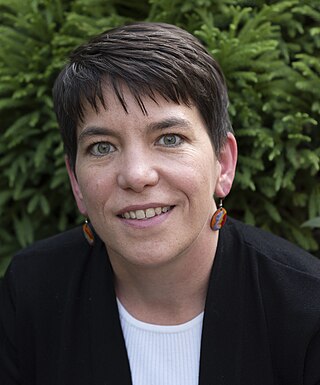
Rhonda M. Stroud is a materials physicist and planetary scientist at Arizona State University, where she serves as Director of the Buseck Center for Meteorite Studies. From 1998- 2022, she was a Research Physicist at the United States Naval Research Laboratory, where she led the Nanoscale Materials Section. She is known for her research on nanostructures, including quasicrystals and aerogel, and on the materials that make up comets and cosmic dust. She pioneered the use of focused ion beam technology in the study of meteorites.
Katharina Lodders is a German-American planetary scientist and cosmochemist who works as a research professor in the Department of Earth and Planetary Sciences at Washington University in St. Louis, where she co-directs the Planetary Chemistry Laboratory. Her research concerns the chemical composition of solar and stellar environments, including the atmospheres of planets, exoplanets, and brown dwarfs, and the study of the temperatures at which elements condense in stellar environments.
References
- 1 2 "NASA Historical Data Book". history.nasa.gov.
- ↑ Marvin, Ursula B. (2001). "Oral Histories in Meteoritics and Planetary Sciences: Edward Anders". Meteoritics & Planetary Science . 36 (2): A225–A267. Bibcode:2001M&PSA..36..255M.
- ↑ Compton, David W. (1989). "Where No Man Has Gone Before: A History of Apollo Lunar Exploration Missions". NASA Special Publication 1214, Chapter 11, Section 4, "The First Lunar Science Conference.".
- ↑ Goldman, Randy M. (February 28, 1997). "Oral History Interview With Edward Anders". U.S. Holocaust Memorial Museum.
- ↑ Holian, Anna (May 2008). "Displacement and the Post-War Reconstruction of Education: Displaced Persons at the UNRRA University of Munich, 1945-1948". Contemporary European History . 17 (2): 167–195. doi:10.1017/S0960777308004360. JSTOR 20081400. S2CID 145344395.
- ↑ United States of America v. Wilhelm von Leeb, et al.,p. 9034-9036(U.S. Military Tribunal, NurembergAugust 2, 1948).
- ↑ "Jack Miller Teaching Awards". Columbia Chemistry. September 9, 2015. Retrieved October 20, 2019.
- ↑ Marvin, Ursula B. (2001). "Oral Histories in Meteoritics and Planetary Sciences: Edward Anders". Meteoritics & Planetary Science . 36 (2): A225–A267. Bibcode:2001M&PSA..36..255M.
- ↑ "Newcomb Cleveland Prize Recipients". American Association for the Advancement of Science.
- ↑ "History of Meteorites Studied". New York Times. October 25, 1959.
- ↑ Sullivan, Walter (June 11, 1961). "A New Way Found to Make Diamonds". New York Times.
- ↑ "Science Academy Elects 96 Members". New York Times. April 28, 1974.
- ↑ B. Srinivasan and E. Anders, Science201, 51-56 (July 7, 1978)
- ↑ Lewis, R.S.; Tang, M.; Wacker, J.F.; Anders, E.; Steel, E. (1987). "Interstellar Diamonds in Meteorites". Nature . 326 (6109): 160–162. Bibcode:1987Natur.326..160L. doi:10.1038/326160a0. S2CID 4324489.
- ↑ Anders, Edward; Zinner, Ernst (1993). "Interstellar Grains in Primitive Meteorites: Diamond, Silicon Carbide, and Graphite". Meteoritics and Planetary Science . 28 (4): 490–514. Bibcode:1993Metic..28..490A. doi:10.1111/j.1945-5100.1993.tb00274.x.
- ↑ Huyghe, Patrick (November 1991). "Stardust Memories". Discover. Burbank, California: Disney Publishing.
- ↑ Wolbach, Wendy S.; Lewis, Roy S.; Anders, Edward (October 11, 1985). "Cretaceous Extinctions: Evidence for Wildfires and Search for Meteoritic Material". Science . 230 (4722): 167–170. Bibcode:1985Sci...230..167W. doi:10.1126/science.230.4722.167. PMID 17842693. S2CID 22661861.
- ↑ Wolbach, Wendy S.; Gilmour, Iain; Anders, Edward; Orth, Charles J.; Brooks, Robert R. (August 1, 1988). "Global fire at the Cretaceous-Tertiary Boundary". Nature . 334 (6184): 665–669. Bibcode:1988Natur.334..665W. doi:10.1038/334665a0. S2CID 4280587.
- ↑ "Global Fire Is Linked to Dinosaur's Demise". New York Times. August 30, 1988.
- ↑ Anders, Edward; Grevasse, Nicolas (January 1989). "Abundances of the chemical elements: Meteoritic and solar". Geochimica et Cosmochimica Acta . 53 (1): 197–214. doi:10.1016/0016-7037(89)90286-X. S2CID 40797942.
- ↑ Google Scholar
- ↑ Anders, Edward; Dubrovskis, Juris (Spring 2003). "Who Died in the Holocaust? Recovering Names From Official Records". Holocaust and Genocide Studies . 17 (1): 114–138. doi:10.1093/hgs/17.1.114. PMID 20684094.
- ↑ "Memorial Wall – Liepāja Jews in WWII".